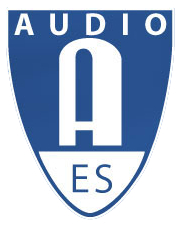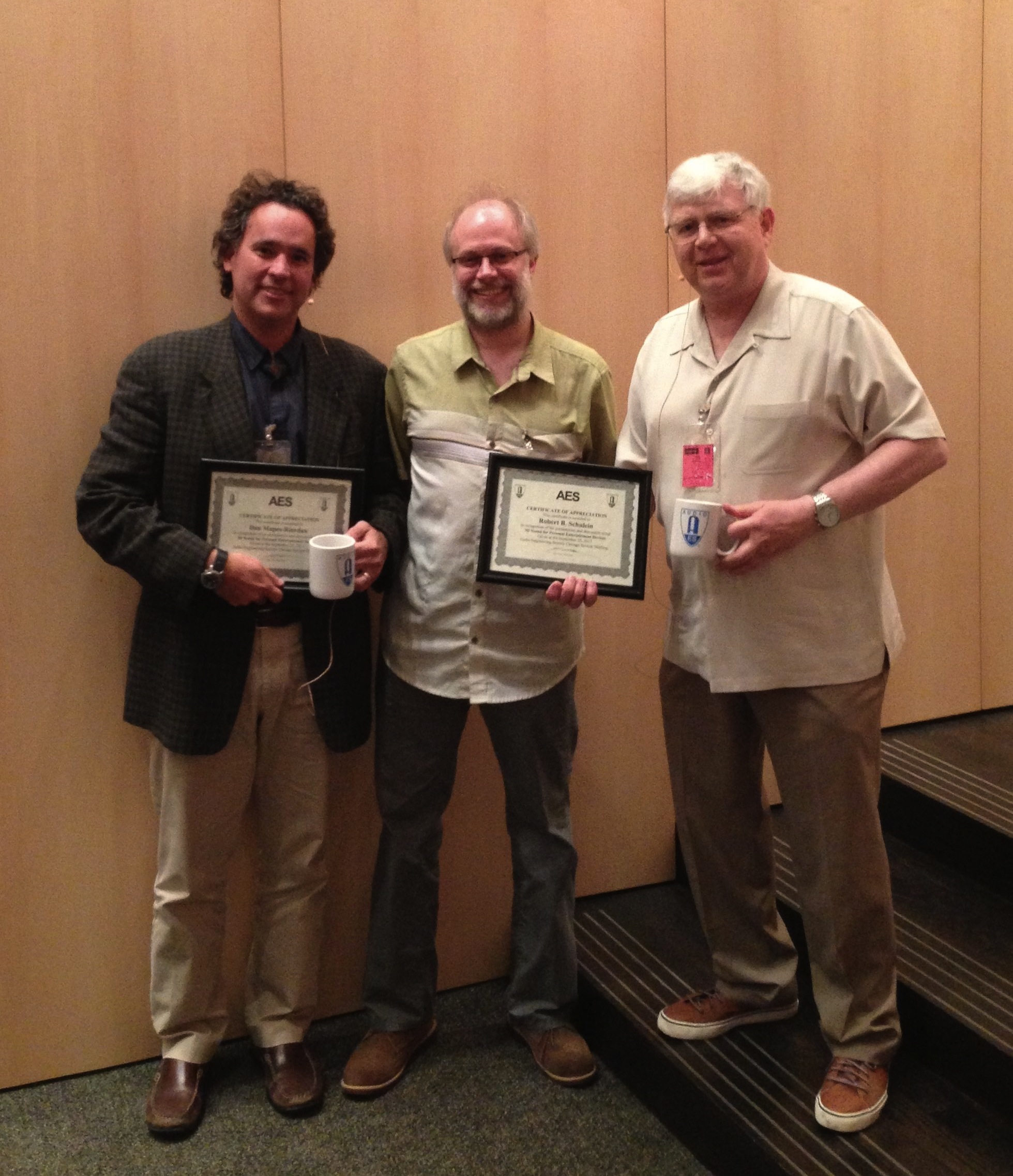
Audio Engineering Society
Chicago SectionMeeting Recap - September 25, 2013
 AES
Chicago Section Meeting Recap
AES
Chicago Section Meeting Recap
Meeting Date: September 25, 2013
Written By: Ken Platz
Topic: 3D Sound for Personal Entertainment Devices
Presented by: Robert B. Schulein and Dan Mapes-Riordan
The September 25, 2013, meeting of the Chicago AES Section was held at
Shure Incorporated, located in Niles, Illinois. About forty audio
enthusiasts (members, non-members, and several UIC students) attended the
presentation in the S.N. Shure Theater, listened to demos using wireless
headphones, and then rotated through three table stations that were set up
in the lobby to compare listening over pairs of headphones versus
loudspeakers.
Bob Schulein started his presentation by giving an overview of 3D audio. In
a ‘quest for realism’ we want to have the impression that sound can come
from anywhere. We often find what is missing is having more sensory inputs
or a spatial reality. Trends in 3D audio are emphasizing headphone
listening which provides a 3D-enhanced listening experience with (only) two
speakers. It’s not surprising that the consumer electronics industry is
always active in creating more exciting ways to provide an enveloping
auditory experience. In this quest, at times it appears that offerings are
‘solutions looking for problems to solve.’
Wireless headsets were distributed to the audience which enabled our group
to listen to and compare various demos that Mr. Schulein queued using
different consumer product offerings such as Dolby Headphone, DTS Headphone
X, Jawbone’s ‘Jambox’, Longcat, Fraunhofer’s ‘Nexus 7 Cingo’, and ImmersAV.
A consensus from the group was that it was relatively easy to identify and
locate each independent channel (in the channel-demos) but it became more
difficult to distinguish between the 3D-processed versus stereo demos when
listening to movie or music content.
Dan Mapes-Riordan presented an overview of his work on how
cross-talk-cancellation (CTC) affects listening over loudspeakers. There
are past and present efforts attempting to use CTC to convert binaural
content created for headphones so it can be played over loudspeakers which
provide more playback opportunities and offer stabile frontal imaging.
Although many are still looking…he believes that there is no single
analytical solution that provides optimum CTC (where the CTC audio is
indistinguishable from the original audio). ImmersAV has found that stereo
pair loudspeaker placement at +/- 30 degrees is the best positioning (or at
the very least, a good starting point). By using a custom EQ and 256 point
filters, they have confirmed that 20dB CTC is achievable. Also, avoiding
reflective surfaces and having good room absorption is a given.
Once we were able to thank each of our presenters with a Certificate of
Appreciation and honorary AES mug, we convened to the lobby to listen to
each of the three loudspeaker vs. headphone setups: Genelec powered
near-field monitors + headphones with iPad video; M-Audio powered
near-field monitors + headphones with iPad video; and small powered ‘mini
speakers’ + headphones with iPhone video.
The Chicago AES Section would like to extend a special thanks to Robert B.
Schulein and Dan Mapes-Riordan for their respective presentations, for
setting up and providing the wireless and wired demos, and for their
efforts in striving for (and providing) an improved listening experience.
Dan Mapes-Riordan's Biography:
Bob Schulein's Biography:
Bob Schulein has been involved with the design, development, manufacturing, and marketing of electro-acoustical products for over 40 years. He is the owner of RBS Consultants, an international consulting firm in Schaumburg, Illinois, which provides consulting services in areas of acoustics, product research, product design and development, project management, and audio/video recording engineering and producing.
His areas of specialization include professional and consumer audio products and applications, telecommunications and the hearing-health industry.
Bob received BSEE and MSEE degrees from the University of Wisconsin, Madison, where he did research on piezoresistive semiconductor transducers.
Prior to forming his own consulting firm, Bob held positions at Shure, Inc., and Etymotic Research, Inc., in design, development, engineering management, corporate division management, and senior corporate management. During this period, his focus was in areas of consumer electronics, professional audio, telecommunications systems, audiology, and hearing-aid component development.
While at Shure, Bob managed the Home Theater Sound (HTS) division, which pioneered the development of the first enhanced matrix decoders emulating the professional Dolby products in theaters. This work led to the development of a complete line of processors, power amplifiers, and loudspeakers for high-end home theater systems, predating the introduction of THX performance concepts. The HTS division also developed and pioneered the use of enhanced matrix encoders and decoders for professional applications. Bob introduced matrix surround-sound encoding to baseball television broadcasting, episodic television, Saturday Night Live, The Grammy Awards broadcast, and Super Bowl XXIV in 1990.
Bob's earlier work at Shure was in the area of condenser-microphone research, development, and design. He led the group effort to introduce Shure's first professional condenser microphone, the SM-81.
Bob has been granted 25 patents in the fields of acoustics and electro-acoustics and has 2 patents pending.
Bob has been active in a number of professional organizations within the audio and hearing industries. He is a Fellow and Past President of the International Audio Engineering Society, where he received the Publications Award in 1977, the Board of Governors Award in 1990 and the Bronze Metal in 2013.
He currently serves as a vice-chair of the AES Technical Council, and is chair of the AES Technical Committee on Hearing and Hearing Loss Prevention. Bob is a member the American Auditory Society as well as the American National Standards Institute S3WG48 working group on hearing-aid measurements.
Bob's long interest and successful track record in solving difficult engineering problems has led to his development of miniature directional microphones for hearing aids, an acoustically transparent non-porous wax barrier for the hearing aid industry, and an advanced professional in-ear monitoring system used by major performers. It was the high-performance patented binaural audio technology used in these in-ear monitoring systems that served as a major component of ImmersAV Technology.
Dan Mapes-Riordan, PhD., has over 25 years experience as an R&D engineer in the audio industry. His interest in audio can be traced back to his years as a radio station DJ in high school (WJHS), college (WMTU), and graduate school (WREK). His educational background is in digital electronics, signal processing, acoustics, and auditory perception. He has worked in a variety of areas including digital audio testing, transducer design, echo cancellation and feedback reduction, dynamics processing, hearing test instrumentation, speech processing, surround sound, and binaural recording and playback. He has taught statistics and architectural acoustics at the college level. Dan has been awarded eight patents and has two patents pending. He currently is a staff engineer/scientist at Etymotic Research, Inc. He is also an associate technical editor of the Journal of the Audio Engineering Society. His hobbies include listening to live music and sailing.